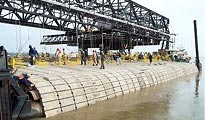|
Construction Begins
With Concrete Mat Placement
January, 2002 – Construction
work on the Greenville Bridge reached into the waters
of the Mississippi River on Monday, December 10, 2001,
as the U.S. Army Corps of Engineers began laying prefabricated
ribbons of concrete called Articulated Concrete Mattress
(ACM) on the bottom of the river. ACM was laid in
the areas where support caissons and piers for the new
bridge will eventually be located. The concrete mattress
stabilizes the river bottom and will prevent scouring
— the erosion and excavation of soil caused by river
current — when caissons and other structures needed
for construction are sunk through the mattresses and
into the river floor.
Historically, bridge builders have used
a basket-like mattress of woven wood planks to control
scouring during caisson work. Timber mattresses
are built on shore and floated into position, then piled
with enough crushed stone to sink them to the river
floor — a time consuming process that requires expert
control. The placement of timber mattress would have
taken about three months; laying of articulated concrete
mattresses took less than 5 days.
Articulated concrete panels are typically
used by the Corps of Engineers in river bank stabilization
or "revetment" operations. The Greenville
project represents the first use of ACM in bridge construction
— another footnote in the history of Mississippi River
bridges.

|
December, 2001: The U.S. Army Corps of
Engineers lays concrete mat on the bottom
of the Mississippi River.
|
|
THE MAT LAYING PROCESS
Concrete mats are laid by a vessel conveniently
called the Concrete Mat Boat, assigned to the U.S. Army
Corps of Engineers, Vicksburg District. The mat boat
is the only vessel of its kind in the world, a floating
assembly floor where prefabricated concrete panels are
laid out and stitched together.
In the process:
- Stacks of panels are ferried to the
back of the mat boat by barge; each panel consists
of 16 concrete blocks that are wired together to form
a panel roughly 25 feet long, 4 feet wide and 4 inches
thick (7.6m x 1.2m x 10.2cm).
- Panels are lifted from the barge and
placed on the assembly floor. Workers with wire tying
tools stitch the panels together. When the tying is
done, the panel is edged forward into the water. More
panels are tied onto the trailing edge, the process
repeats and the ribbon of concrete gets longer.
- The concrete mattress that slides into
the water is 35 panels wide, or 140 feet (43m). Workers
lay three strips on each side of the river, starting
approximately 300 feet (91m) from shore. Strips are
overlapped by about 10 feet (3m); each strip is roughly
450 feet (43m) long. The concrete mats will provide
more than 175,000 feet (16,000 square meters) of coverage
on each side of the river.
Photos of the mat boat and the ACM assembly
process are available on the Construction Photo Album
page dated December
13, 2001.
LAYING THE FOUNDATION
Construction activity during 2002 will take place largely
under water as concrete support caissons for
the two main bridge towers are poured and sunk into
the bottom of the river. Pouring of caissons is scheduled
to begin in January.
- To prepare for pouring, the contractor
will build chevron-shaped breakwaters at the
two caisson sites, located approximately 596 feet
(181.5m) from shore on both sides of the river. Breakwaters
are built with walls of steel fastened to 6-foot (1.8m)
diameter steel pipe that is driven into the river
bottom. The river is 70 to 80 feet (21 to 24m) deep
at both locations. Breakwaters will protect the caisson
sites from the strong river current and support a
caisson guide — a track also made of steel
pipe — that will assist in the accurate placement
of the caissons as they are sunk.
- To support the breakwater and the
caisson guide, a series of 6-foot (1.8m) diameter
steel pipes will be driven into the river bottom.
- Once the breakwaters are in place,
a steel box form called a cutting edge will
be floated out to both sites and positioned in the
caisson guide. Concrete will be poured to fill the
cutting edge, which will eventually become the bottom
of the caisson after it is sunk into the river bed.
Subsequent pours into forms atop the cutting edge
will create a long, hollow concrete column.
- As concrete is added, the cutting edge
will slowly descend down the caisson guide until it
reaches the river bottom.
Selected questions
regarding construction of the Greenville Bridge
are periodically answered on our
Ask The Engineer page. Submit your questions
by e-mail to learn@greenvillebridge.com. |
|